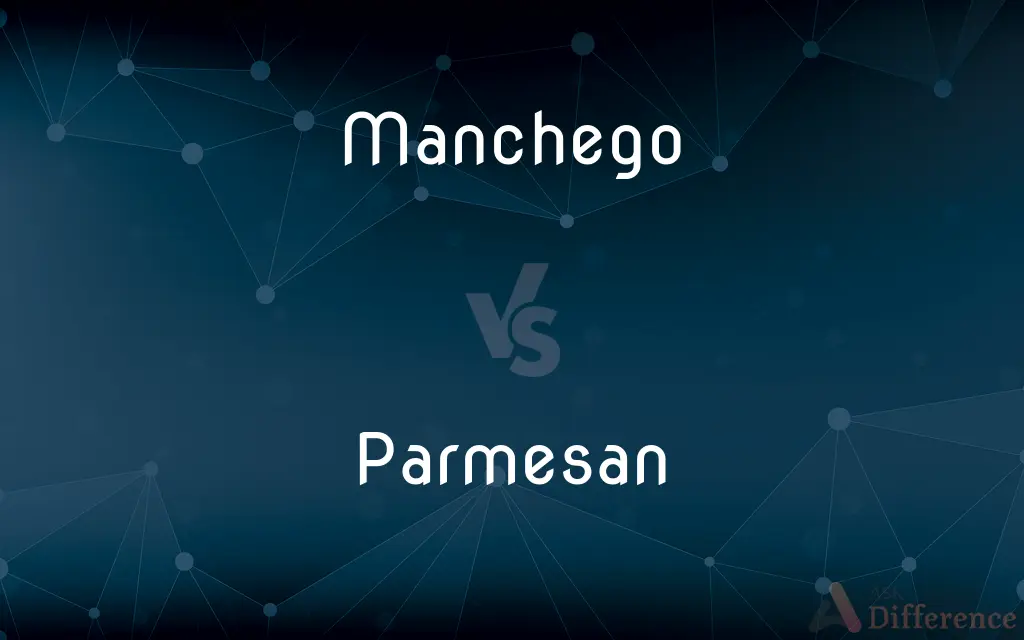Manchego vs. Parmesan — What's the Difference?
Edited by Tayyaba Rehman — By Maham Liaqat — Updated on March 11, 2024
Manchego is a Spanish cheese from sheep's milk with a buttery taste, while Parmesan is an Italian cow's milk cheese known for its hard texture and sharp flavor.

Difference Between Manchego and Parmesan
Table of Contents
ADVERTISEMENT
Key Differences
Manchego cheese originates from the La Mancha region of Spain and is made exclusively from the milk of Manchega sheep. It has a distinctively rich, buttery taste and a firm texture. The cheese is aged between 60 days to 2 years, developing a nutty and caramel flavor over time. On the other hand, Parmesan, or Parmigiano-Reggiano, is a hard, granular cheese from Italy, specifically from the regions of Parma, Reggio Emilia, Modena, and Bologna. It's produced using cow's milk and is aged for a minimum of 12 months, often up to 36 months or longer, which contributes to its sharp, complex flavor and slightly gritty texture.
Manchego is protected by a Designation of Origin (D.O.), meaning it must adhere to strict production methods and geographical criteria. This ensures the cheese's quality and authenticity. In contrast, Parmesan cheese, especially when labeled as Parmigiano-Reggiano, is protected under the Denominazione di Origine Protetta (DOP) standards, requiring production to follow traditional methods within the designated Italian regions. Both designations protect the reputation of these cheeses, ensuring consumers receive a product made according to traditional methods.
The texture of Manchego can vary from semi-soft to very hard, depending on its age. Younger Manchego cheeses tend to be softer and more moist, making them suitable for a variety of culinary uses beyond just grating, including melting in dishes or serving as a table cheese. Parmesan, known for its hard, crystalline texture, is primarily used grated over dishes like pasta, risotto, and salads or eaten as a snack or antipasto, often accompanied by nuts, honey, or figs.
Manchego's flavor profile is characterized by its creamy, nutty, and sometimes slightly piquant taste, especially in older varieties. It pairs well with quince paste (membrillo) and a variety of wines, from light whites to robust reds. Parmesan boasts a bold, umami-rich flavor with notes of nuttiness and a savory depth that enhances the taste of a wide range of dishes. Its robust flavor profile makes it an excellent cheese for grating over foods to add a burst of flavor.
In terms of nutritional content, both cheeses are rich in proteins and calcium, but their fat content can differ due to the type of milk used. Manchego, made from sheep's milk, generally has a higher fat content compared to Parmesan, which is made from partially skimmed cow's milk. This difference can also affect their calorie count, with Manchego typically being higher in calories than Parmesan.
ADVERTISEMENT
Comparison Chart
Origin
Spain
Italy
Milk Source
Sheep's milk
Cow's milk
Texture
Ranges from semi-soft to very hard
Hard, granular
Aging Period
60 days to 2 years
12 to 36 months or more
Flavor
Buttery, nutty, caramel
Sharp, complex, slightly gritty
Certification
D.O. (Designation of Origin)
DOP (Denominazione di Origine Protetta)
Culinary Uses
Table cheese, melting, grating
Grating, snacks, antipasto
Compare with Definitions
Manchego
A Spanish cheese made from Manchega sheep's milk, known for its rich, buttery flavor.
She served slices of Manchego cheese alongside quince paste at the dinner party.
Parmesan
An Italian hard cheese from cow's milk, celebrated for its sharp and complex flavor.
He generously grated Parmesan over the freshly cooked pasta for added depth.
Manchego
Originates from the La Mancha region of Spain.
Authentic Manchego cheese must come from La Mancha, following traditional production methods.
Parmesan
A staple in Italian cuisine, originating from specific regions like Parma.
Authentic Parmesan, or Parmigiano-Reggiano, is a product of Italy's rich cheese-making tradition.
Manchego
Aged from 60 days to over 2 years, influencing its texture and taste.
The two-year-aged Manchego had a complex flavor that was both nutty and deep.
Parmesan
Known for its deep umami and nutty undertones.
The Parmesan added a bold, savory note to the risotto, elevating the dish.
Manchego
Pairs well with quince paste and a variety of wines.
For the wine tasting, they paired an aged Manchego with a robust red wine.
Parmesan
Essential for grating over dishes and enjoyed as a snack.
Apart from its use in cooking, they savored thin slices of Parmesan with figs as an appetizer.
Manchego
Creamy and nutty, with variations from mild to piquant.
The young Manchego was especially creamy, with a mild but distinctive taste.
Parmesan
Requires at least 12 months to age, often much longer for premium quality.
The 24-month-aged Parmesan had an intensely sharp flavor and a slightly gritty texture.
Manchego
Manchego (officially Spanish: queso manchego, pronounced [ˈkeso maɲˈtʃego]) is a cheese made in the La Mancha region of Spain from the milk of sheep of the Manchega breed. It is aged between 60 days and 2 years.
Parmesan
A hard, sharp, dry Italian cheese made from skim milk and usually served grated as a garnish.
Manchego
A firm cheese made from sheep's milk, having a piquant, nutty flavor and small holes, made in the region of La Mancha in Spain.
Parmesan
A hard, full-fat Italian cheese from Parma.
Manchego
Alternative form of Manchego
Parmesan
(by extension) A similar cheese produced elsewhere.
Parmesan
(slang) Money.
Parmesan
Of or pertaining to Parma in Italy.
Parmesan
Parmesan cheese.
Parmesan
Hard dry sharp-flavored Italian cheese; often grated
Common Curiosities
What distinguishes Manchego from Parmesan in terms of production?
Manchego is made from sheep's milk and adheres to Spanish D.O. standards, while Parmesan is made from cow's milk under Italian DOP regulations.
Are there vegetarian versions of these cheeses?
Traditional productions use animal rennet, but vegetarian options may be available, using plant-based coagulants.
How do the flavors of Manchego and Parmesan compare?
Manchego has a creamy, nutty flavor, while Parmesan is known for its sharp, umami-rich profile.
What wines pair well with Manchego?
Light whites to robust reds pair well, depending on the cheese's age.
How should these cheeses be stored?
Both should be wrapped in parchment or cheese paper and stored in the refrigerator's less cold section to maintain their texture and flavor.
Can both cheeses be eaten alone?
Yes, both can be enjoyed alone. Manchego pairs well with fruits and wines, while Parmesan can be savored with nuts and honey.
What are the health benefits of Manchego and Parmesan?
Both are high in calcium and protein, but they should be consumed in moderation due to their fat and salt content.
Can Manchego and Parmesan be used interchangeably in recipes?
While they can be substituted based on personal taste, their distinct flavors and textures can lead to different culinary results.
Is the aging process crucial for these cheeses?
Yes, aging affects their texture, flavor, and overall character significantly.
What dishes benefit most from Parmesan?
Pasta, risotto, and salads are enhanced by Parmesan's bold flavor.
Share Your Discovery

Previous Comparison
Sahara vs. Sahel
Next Comparison
Intelligence vs. WitAuthor Spotlight
Written by
Maham LiaqatEdited by
Tayyaba RehmanTayyaba Rehman is a distinguished writer, currently serving as a primary contributor to askdifference.com. As a researcher in semantics and etymology, Tayyaba's passion for the complexity of languages and their distinctions has found a perfect home on the platform. Tayyaba delves into the intricacies of language, distinguishing between commonly confused words and phrases, thereby providing clarity for readers worldwide.














































